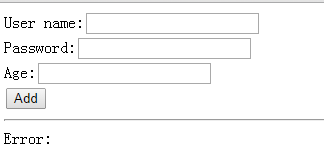使用initbinder做验证的情况一般会在此controller中提交的数据需要有一些是业务性质的,也即比较复杂的验证情况下才会使用。大部份简单的表单验证,使用annotation验证即可以解决。
annotation验证使用方法可参见:https://www.zzvips.com/article/155119.html
这里需要注意的一点:initbinder和annotation两种验证只能二选一,如果使用了initbinder,就不能使用annotation验证。
前面的web.xml和spring.xml的配置就不再重复,可参见上面链接中的配置。一模一样。
直接上代码:
1、user5 model实体类
|
1
2
3
4
5
6
7
8
9
10
11
12
13
14
15
16
17
18
19
20
21
22
23
24
25
26
27
28
29
30
31
32
33
34
35
36
37
38
39
40
41
|
package com.my.controller.bean;import java.util.date;public class user5 { private long id; private string name; private string password; private date createtime; private int age; public long getid() { return id; } public void setid(long id) { this.id = id; } public string getname() { return name; } public void setname(string name) { this.name = name; } public string getpassword() { return password; } public void setpassword(string password) { this.password = password; } public date getcreatetime() { return createtime; } public void setcreatetime(date createtime) { this.createtime = createtime; } public int getage() { return age; } public void setage(int age) { this.age = age; }} |
2、新增一个validator:
|
1
2
3
4
5
6
7
8
9
10
11
12
13
14
15
16
17
18
19
20
21
22
23
24
25
26
|
package com.my.controller.validator;import org.springframework.stereotype.component;import org.springframework.validation.errors;import org.springframework.validation.validationutils;import org.springframework.validation.validator;import com.my.controller.bean.user5;@componentpublic class testvalidator implements validator { @override public boolean supports(class<?> paramclass) { return user5.class.equals(paramclass); } @override public void validate(object obj, errors errors) { user5 user = (user5) obj; validationutils.rejectifemptyorwhitespace(errors, "name", "valid.name", null, ""); if(user.getage() < 18) { errors.rejectvalue("age", "valid.agemin", new object[]{"age" ,18}, "年龄不能小于{1}岁"); } }} |
这里需要加入@component,注入di
3、controller
|
1
2
3
4
5
6
7
8
9
10
11
12
13
14
15
16
17
18
19
20
21
22
23
24
25
26
27
28
29
30
31
32
33
34
35
36
37
38
39
40
41
42
43
44
45
46
47
48
49
50
51
52
53
54
55
|
package com.my.controller;import java.util.linkedhashmap;import java.util.list;import java.util.map;import javax.validation.valid;import org.springframework.beans.factory.annotation.autowired;import org.springframework.beans.factory.annotation.qualifier;import org.springframework.stereotype.controller;import org.springframework.validation.bindingresult;import org.springframework.validation.fielderror;import org.springframework.validation.validator;import org.springframework.web.bind.webdatabinder;import org.springframework.web.bind.annotation.initbinder;import org.springframework.web.bind.annotation.modelattribute;import org.springframework.web.bind.annotation.requestmapping;import org.springframework.web.bind.annotation.requestmethod;import org.springframework.web.servlet.modelandview;import com.my.controller.bean.user5;@controller@requestmapping(value="binder")public class testinitbindercontroller { @autowired @qualifier(value="testvalidator") private validator validator; @initbinder private void initbinder(webdatabinder binder) { binder.setvalidator(validator); } @requestmapping(method=requestmethod.get) public string index() { return "/testinitbinder/index"; } @requestmapping(value="add", method=requestmethod.post) public modelandview add(@modelattribute @valid user5 user, bindingresult result) { modelandview view = new modelandview("testinitbinder/index"); view.addobject("user", user); if(result.haserrors()) { list<fielderror> errs = result.getfielderrors(); map<string, string> maperrors = new linkedhashmap<string, string>(); for(fielderror err : errs) { system.out.println("objectname:" + err.getobjectname() + "\tfieldname:" + err.getfield() + "\tfieldvalue:" + err.getrejectedvalue() + "\tmessage:" + err.getdefaultmessage()); maperrors.put(err.getfield(), err.getdefaultmessage()); view.addobject("errors", maperrors); } return view; } return view; }} |
把validator注入到controller中。
事实上,使用initbinder,在add controller中的err.getdefaultmessage()方法是取不到对应正确的message的。可以看最后的输入打印结果。
4、view
|
1
2
3
4
5
6
7
8
9
10
11
12
13
14
15
16
17
18
19
20
21
22
23
24
|
<%@ page language="java" contenttype="text/html; charset=utf-8" pageencoding="utf-8"%><%@ taglib uri="http://java.sun.com/jsp/jstl/core" prefix="c" %> <%@ taglib uri="http://java.sun.com/jsp/jstl/fmt" prefix="fmt"%><%@ taglib uri="http://java.sun.com/jsp/jstl/functions" prefix="fn" %><%@ taglib prefix="st" uri="http://www.springframework.org/tags" %><%@ taglib prefix="form" uri="http://www.springframework.org/tags/form"%><!doctype html public "-//w3c//dtd html 4.01 transitional//en" "http://www.w3.org/tr/html4/loose.dtd"><html><head><meta http-equiv="content-type" content="text/html; charset=utf-8"><title>init binder</title></head><body> <form:form action="/testspringmvc1/binder/add" method="post" modelattribute="user5"> user name:<input type="text" id="name" name="name" value="${user.name}" /><br/> password:<input type="text" id="password" name="password" value="${user.password}" /><br/> age:<input type="text" id="age" name="age" value="${user.age}" /><br/> <input type="submit" value="add"/> <hr/> error:<br/> <form:errors path="*"></form:errors> </form:form></body></html> |
注意,这里只能使用<form:errors />来取得错误信息,且,这个<form:errors/>一定要在<form:form/>当中。
5、结果测试

点击add button:

打印输出:

可以看到,这里取不到错误的正确信息
事实上,在一个非常复杂表单页面,里头所提交的数据验证有一定的业务逻辑性时,initbinder应该都不多用,因为很多时候我们可以使用一个map,把errors插入进去,在页面读取即可。比如:
map<string, string> errors;
errors.add("name", "user name can not be empty!");
:
:
页面中只需要使用:
|
1
|
<span style="color:red;">${errors.name}<span> |
即可。
以上就是本文的全部内容,希望对大家的学习有所帮助,也希望大家多多支持服务器之家。
原文链接:https://www.cnblogs.com/HD/p/4123686.html

















